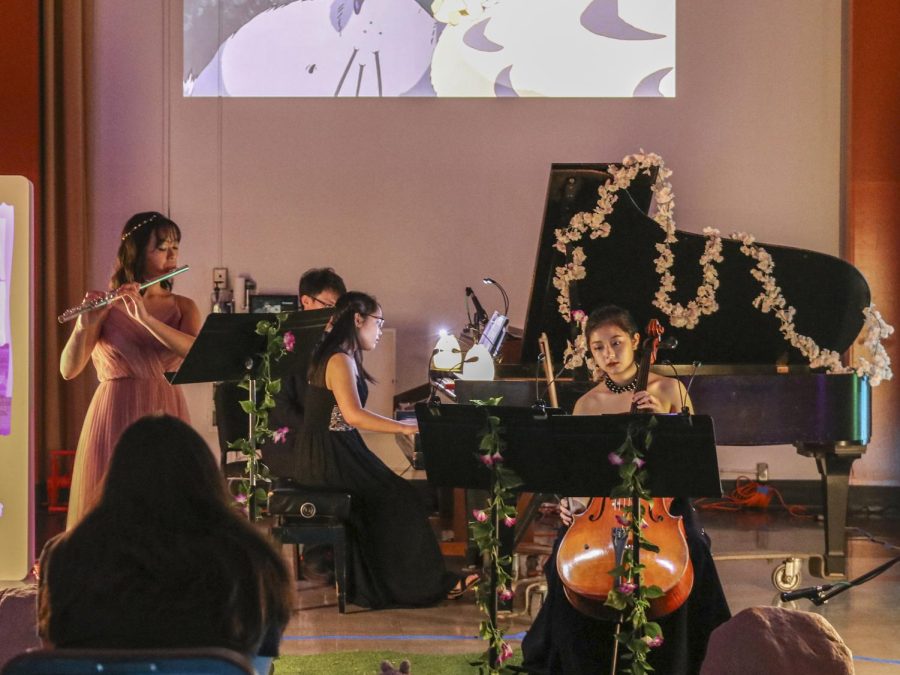The Asian Memory Project reflects on Asian representation through music, art
April 28, 2022
Colorful lights cast playful shadows on the rehearsal room walls. Cherry blossom vines wrap around music stands. Three instruments adorn the Asian Memory Project’s makeshift stage: a grand piano, a cello and a flute. Excited audience members bob their legs up and down from their seats in anticipation as a new environment unfolds before them: the world of Studio Ghibli.
While most concerts held at the Butler School of Music showcase works of classical European composers, members of the Asian Memory Project, a team of 10 UT students, dedicate their performances to celebrating Asian American cultural heritage.
The Asian Memory Project put on two showcases this April, during which they read poetry inspired by Studio Ghibli films, such as the Oscar winner “Spirited Away,” “Howl’s Moving Castle” and “My Neighbor Totoro,” and performed music from their soundtracks. By highlighting Asian media and culture, Asian Memory Project leader Dorothy Le said their work seeks to serve the Asian community of Austin.
Music senior Le said Studio Ghibli played a key role in her childhood by providing characters she could relate to.
“I grew up watching Disney movies and Disney princesses,” Le said. “I always wondered why I never looked like them or why I was never skinny or as pretty as they are. Then, I sought out these Ghibli movies for myself.”
Since discovering her passion for the flute in middle school, Le said she dreamed of performing Studio Ghibli music for a live audience but didn’t think it could be a reality until she went through a period of introspection during the COVID-19 pandemic.
Le said all music students must complete a project-based recital that demonstrates what they learned in the program. Le said her professor, Dr. Marianne Gedigian, inspired her to challenge the traditional concert format of playing pieces from the European canon.
“Being here and studying with Dr. Gedigian, one of the first things she tells us is that you are more than your flutes, and you can do anything with this degree,” Le said. “If I’m going to have my senior recital, it needs to be a celebration, not just a degree checklist.”
Le said anti-Asian discrimination of the past year, including the 2021 Atlanta shooting which claimed the lives of 10 people, left her feeling devastated. She wants to use the Asian Memory Project as a platform to showcase her love for her community.
“That’s when I knew I had to do something,” Le said. “If I were to just follow along the traditional recital route, the traditional degree checklist, to me, that meant that what happened in Atlanta, (what happened) to Asian Americans in the past couple 100 years that we’ve been here, (has) meant nothing.”
Pranav Subramanian, a fifth-year architecture student and set designer for the Asian Memory Project, said the performance aims to bring Asian Americans together through collective childhood experiences.
“We’re looking at it (from) an angle of celebrating Asian American cultural heritage and what that means in this country,” Subramanian said. “A lot of the time, it’s through a shared nostalgia of things like fresh-cut fruits from our parents (and) watching ‘Avatar: The Last Airbender’ on late nights with our siblings. (Studio Ghibli) is a big part of that as well.”
The Asian American population comprises only 8% of Austin and 20.6% of UT students. Subramanian said he views the concert as a way of uplifting other Asian American voices. Because he is from Frisco, Subramanian said he admires the growing Asian population in his hometown and hopes Austin can reach the same heights.
James Gabrillo, a professor of musicology and ethnomusicology at UT, said he believes in music as a medium for connecting people and showcasing diversity, as it allows audiences to reflect on themselves. Gabrillo said the Asian Memory Project provides audiences with a unique experience that allows them to connect with themselves and others, no matter their cultural background.
“(There’s) overlapping communities of identity and culture coming together,” Garbrillo said. “When (audiences) go home, they can take these musical memories with them and personalize them based on their own identity.



